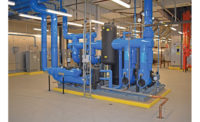Labor Shortage Continues to Challenge Regional Specialty Firms
As construction maintains a strong page, specialty contractors struggle to find qualified workers

The volume of South Florida residential projects, such as the Grove at Grand Bay project, may be on the decline.
PHOTO COURTESY OF THE CIRCLE GROUP

On Florida’s Gulf Coast, the ONE St. Petersburg residential tower would be the city’s tallest building upon completion.
IMAGE COURTESY OF POWER DESIGN

Health care construction, such as this Florida Hospital project, remains a strong market throughout the Southeast region.
PHOTO COURTESY OF KHS&S CONTRACTORS



Specialty contracting firms working in the four-state region of Florida, Georgia and the Carolinas are continuing to see a steady stream of work opportunities, but they remain pressed to find a sufficient number of qualified workers to staff projects.
“Finding skilled labor is our biggest challenge,” says Michael Cannon, president and CEO for KHS&S Contractors, the Tampa-based specialty contractor.
|
Click Here to View the 2016 Southeast Top Specialty Contractors |
“The workforce is fully employed, and the aging labor force is retiring far faster than younger, skilled craftsmen are entering the workforce,” Cannon says. Since construction opportunities should continue to present themselves for the foreseeable future, “We see this as an ongoing challenge over the next few years,” he adds.
Asked by ENR to identify the biggest challenge facing contractors, Carter Hastings, vice president with Power Design, St. Petersburg, says simply, “Finding and retaining labor.”
However, the industry’s labor shortage is hardly confined to the Southeast region. As ENR reported on the Bureau of Labor Statistics’ August employment figures, construction is mostly in a hiring mode, with the most recent month’s jobless rate of 5.1% down from 6.1% a year earlier, but up compared with July, when it came in at 4.5%. The BLS report went on to show a gain of 10,800 positions in the residential construction sector but a decline of 10,700 positions for the non-residential category.
At the same time, a national increase of 2,300 jobs in the architectural and engineering services category suggests some promise for future construction and therefore the potential for the continuation of workforce challenges.
In a statement about the BLS report, Ken Simonson, chief economist with Associated General Contractors of America, indicated the labor shortage could be slowing overall construction activity.
“A variety of indicators suggest contractors would be adding to head count if they could find qualified workers,” Simonson said.
In order to attract workers, some firms are boosting wages and thereby adding pressure to project costs.
“The biggest problem for specialty contractors is getting work at the right price and finding qualified, reliable labor,” says Mike Dominici, vice president with The Circle Group, Atlanta.
“Material prices have increased exponentially and labor costs have risen due to shortages, but generally prices have not increased at the same rates,” Dominici notes. Further challenging specialty firms is the sometimes skewed expectations of both project owners and general contractors, he adds.
“It seems some owners and builders have fixed unit rates plugged into their budgets based on historical cost data which may not properly account for the actual degree of cost escalation or for the project design,” he says.
Contractors utilizing an integrated project delivery-style method, with prequalified subcontractors fully involved with the preconstruction effort and utilizing fast-track LEAN-type scheduling “makes the most sense” for today’s market, Dominici adds. “There are still other price-driven general contractors that are content to blanket the market for pricing with little regard for qualifications or relevant experience,” he says. “We try to avoid those firms.”
Overall, the Southeast is showing a sustainable level of contracting opportunities across multiple construction sectors, says Cannon with KHS&S.
“Nearly all markets that were slow during and right after the recession are currently active,” he says. “We aren’t seeing activity as robust as before the recession, but it is steady, which we prefer; huge booms eventually lead to huge declines.”
Still, the multifamily sector—one of the Southeast’s strongest markets over the past few years—is starting to show signs of weakness, with news of South Florida developers slowing or halting sales of condominium units one sign of a slowdown.
“We believe there is weakness in the residential condominium market,” Cannon says. “As this market declines and contractors migrate away from it, other sectors will be impacted.”
At the same time, in Atlanta, “it appears (multifamily construction) may have hit its peak as some projects remain shelved,” says Dominici. “There is an obvious glut of new large-scale projects under construction, which has everyone asking, ‘Who is going to fill all of these new units?’”
About the Ranking
The regional construction market’s continuing strength is shown in the data reported via ENR Southeast’s annual Top Specialty Contractors survey, which provides firms’ 2015 revenue figures earned from the states of Florida, Georgia, North Carolina and South Carolina. In addition to revenue, the main ranking includes other information about each firm, such as top markets and largest recent contracts. Breakout lists rank firms based upon state and specialty market sector revenue.
In all, respondents to this year’s survey collectively reported more than $6.2 billion in 2015 revenue, compared with the $4.99 billion reported a year ago. While much of that increase results from No. 1-ranked MasTec returning to the ranking after not participating last year, that still marks a roughly $500-million overall revenue gain.
We invite you to read on for further perspective on the Southeast construction market.







